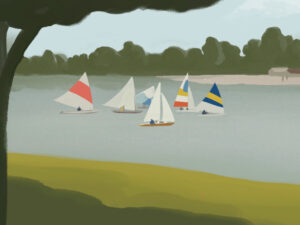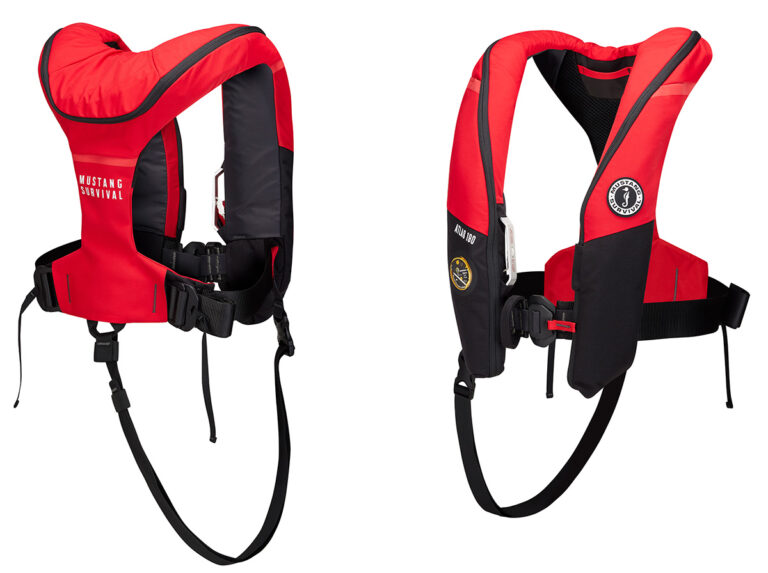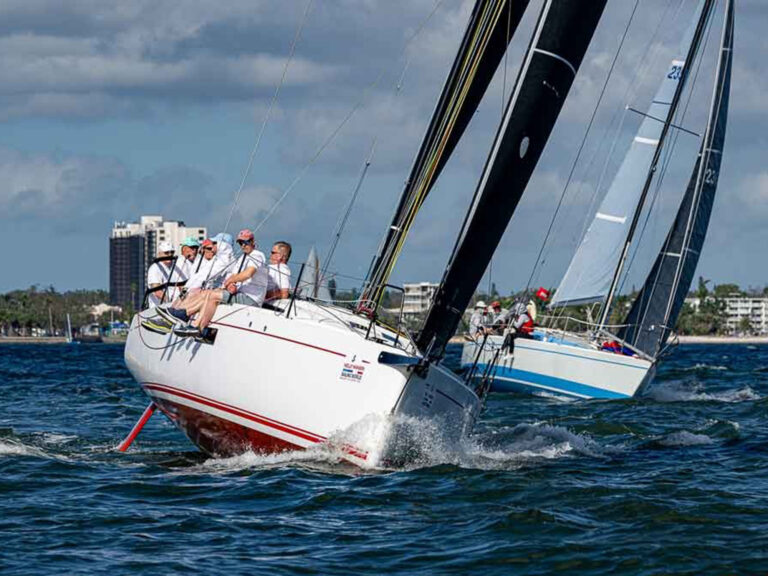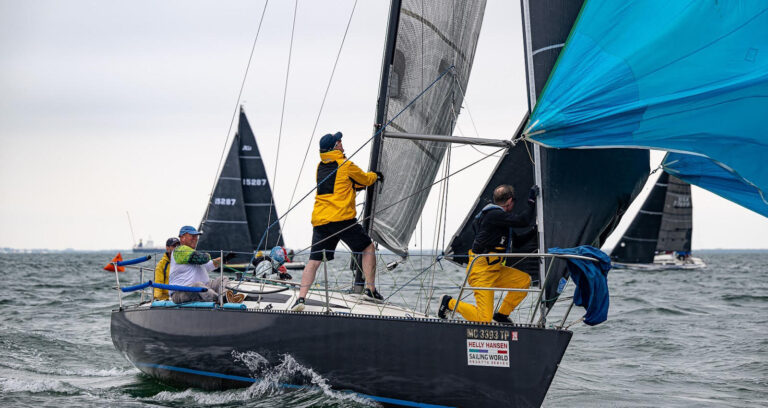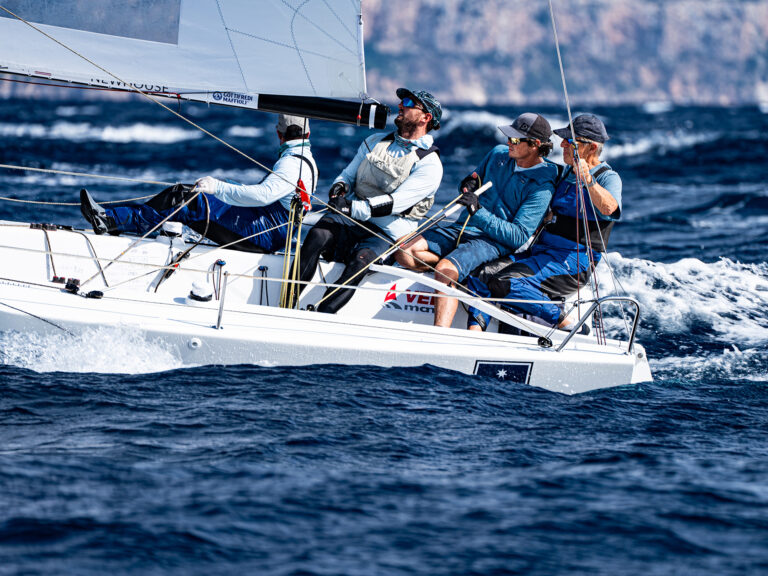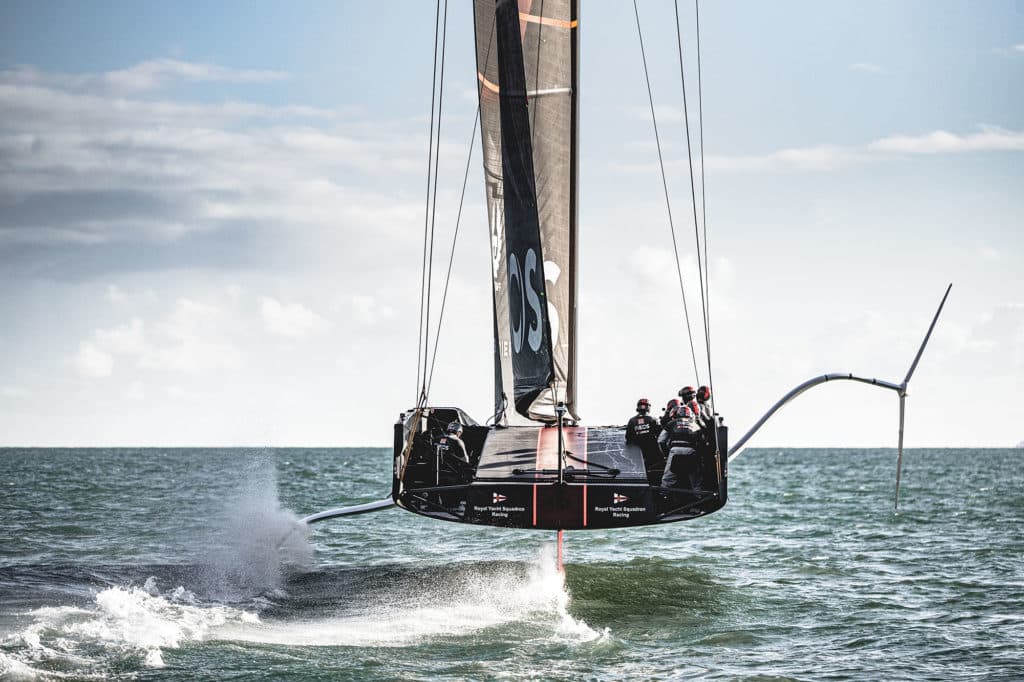
The launching of a new boat is always a special moment, especially for an America’s Cup team, because it’s a defining and major milestone in the campaign. Until the sequential revelations from Emirates Team New Zealand, American Magic, Luna Rossa Prada Pirelli Team and finally Ineos Team UK, development and design had happened behind tightly closed doors or through small-boat testing; we are now in a period of reckoning for the four challengers on a number of fronts.
Internally for each team, the next phase is about validating design tools and debugging many of the new detailed design features found everywhere on the boat. Externally, it’s checking in with the solutions of the other teams and understanding why they chose certain directions. Moving forward from the launches of these first-generation AC75s, design teams will adjust and simulate the different directions, if they haven’t already; but only when the sailing teams actually line up in Cagliari, Italy, at the end of April will we know who is on the best track.
To make an early assessment, we must first consider the overall package, starting with the hull and deck. Considerations of whether the America’s Cup races in Auckland in 2021 will be sailed in foiling conditions or how often or in what windspeed will a team drop off the foils when tacking is important. There is likely much discussion about the minimum true-windspeed in which these boats will race. One thing is for sure, the racing will be pretty boring to watch if these AC75s are not foiling.
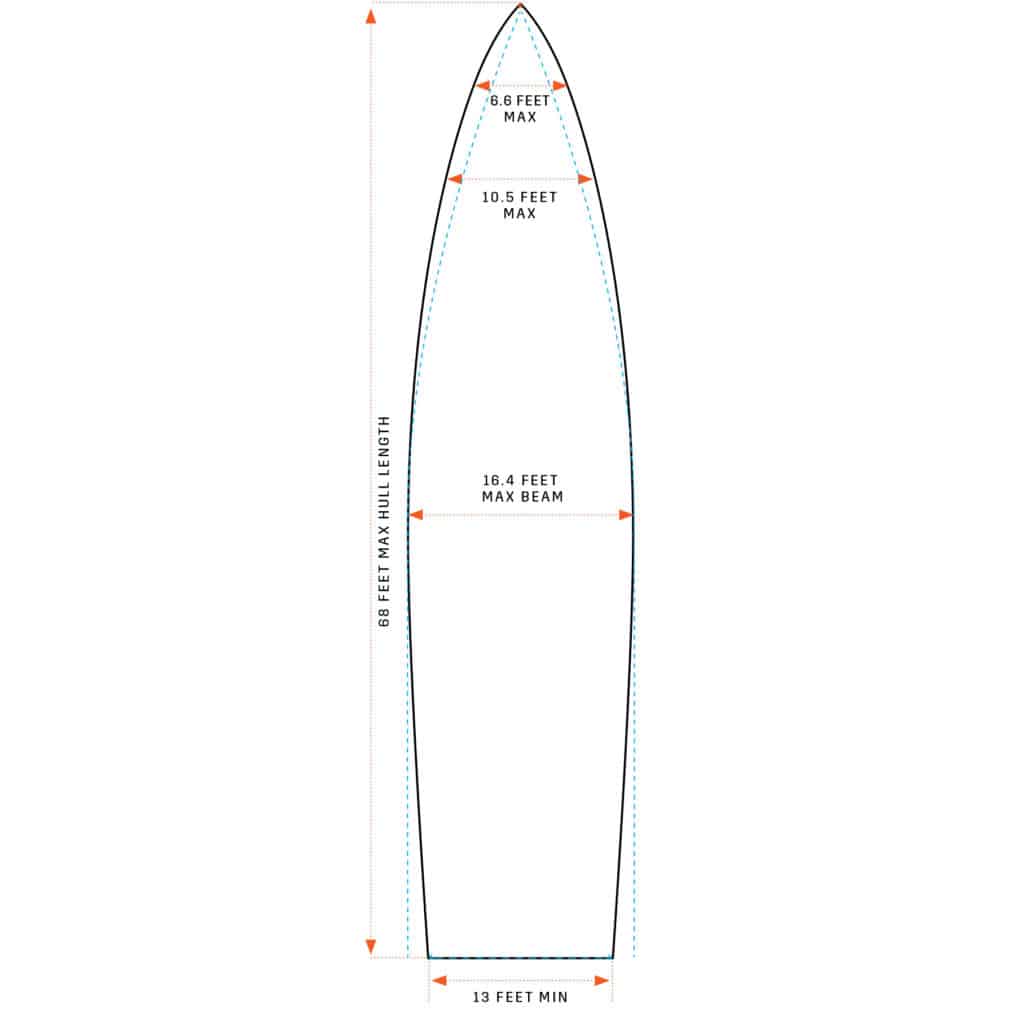
Before getting into the details of the different solutions, however, it’s important to point out some of the hull and deck limitations defined by the AC75 box rule. The illustration above shows a perimeter line, which is the projected shadow of the boat’s outline, down to the measurement water plane (MWL). There are minimum and maximum dimensions that the perimeter line must pass through, or be within, which limits the shapes of the hull to a certain extent. The strictest limits are hull length—basically 68 feet—and beam, which is set at 16 feet.
The deck is also called the upper hull surface, and it is anything above this perimeter line. The minimum height of the bowsprit is 3 feet above MWL. The mast-rotation point is specified at 5 feet above MWL and a fixed distance from the transom, so the mast position is set. Another important parameter that affects the overall hull and deck shape is the cockpit sole, which must be at least 4 inches above the MWL. This leaves a roughly 4-foot cockpit cavity to hide the crew below the mast ball. A big, strong grinder (arm grinding is required this time) needs at least 5.5 feet to be mostly upright and efficient.
Other requirements are based on hull volume. For example, a minimum bow volume forward of the 31-foot plane is 40 cubic meters, in consideration of pitch-pole prevention. Similarly, for stability, the 90-degree capsized volume of the hull and deck in the water must be at least 32 inches above MWL, so there needs to be significant volume above the waterline so that the boat will have some tendency to right itself. There are a few other stability requirements to ensure a minimum righting moment with the boat upright, which keeps some level of required transverse waterline fullness.
With the AC75, we probably need to replace the term “sheer line,” which used to be an important aesthetic consideration even with race boats, with the “perimeter line.” The perimeter line, as mentioned earlier, is the outermost portion of the hull tangent to the tumblehome shapes we see on these boats. The packages of both Ineos UK and American Magic push the perimeter line down close to MWL, for a softer leading-edge bow shape and better lead into the airflow around the jib.
Emirates Team New Zealand and Luna Rossa have more slab-sided bow profiles. Three of the teams opted to put the aft perimeter point quite low. Team New Zealand and the Italians look the lowest, with American Magic and the outlier Ineos being the most radical by pushing their middle and aft points at least 1 foot above the mast rotation and carrying their maximum beams all the way aft, resulting in a barge‑like appearance.
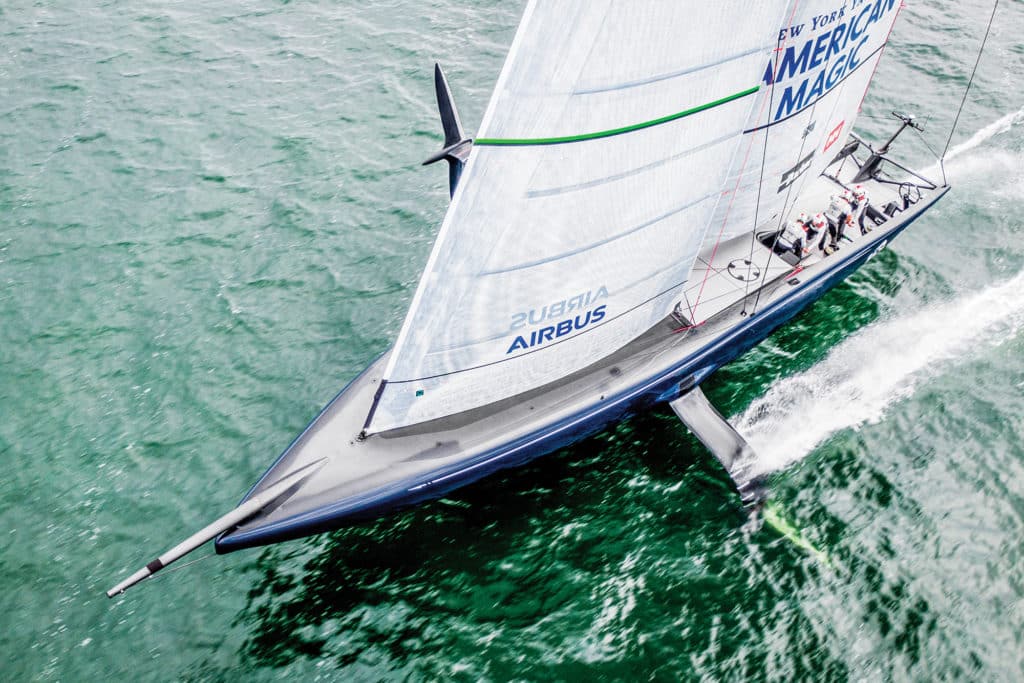
Again, these are all aerodynamics-based decisions and directly connected with the deck layout, crew positioning and grinding-pedestal heights. Each team is trying to keep crews out of the free stream as much as possible and has chosen to create a centerline deck endplate aft of the mast that tapers down to a narrow trailing edge at the transom. This approach minimizes vortices as the airflow exits the hull.
Each team will eventually seal the mainsail down to this surface for the best efficiency from the mainsail.
The centerline cockpit structure essentially locks most of the crew into set positions, so it looks as if three of the teams have chosen to keep all eight grinders in permanent spots (four each to port and starboard), with the helmsmen and trimmer being the only sailors switching sides behind the traveler track. Ineos, in contrast to the other teams, placed two grinding pedestals forward of the helmsman station and two aft, allowing for all of the crew to be on one side of the boat to take advantage of the extra righting moment. This also explains why it carried its maximum beam all the way aft and high—to shield the crewmembers and keep them outboard. Maneuvers on Ineos’ Britannia will require a bit more calisthenics and coordination transferring from side to side, as well as the additional weight of four additional grinding pedestals.
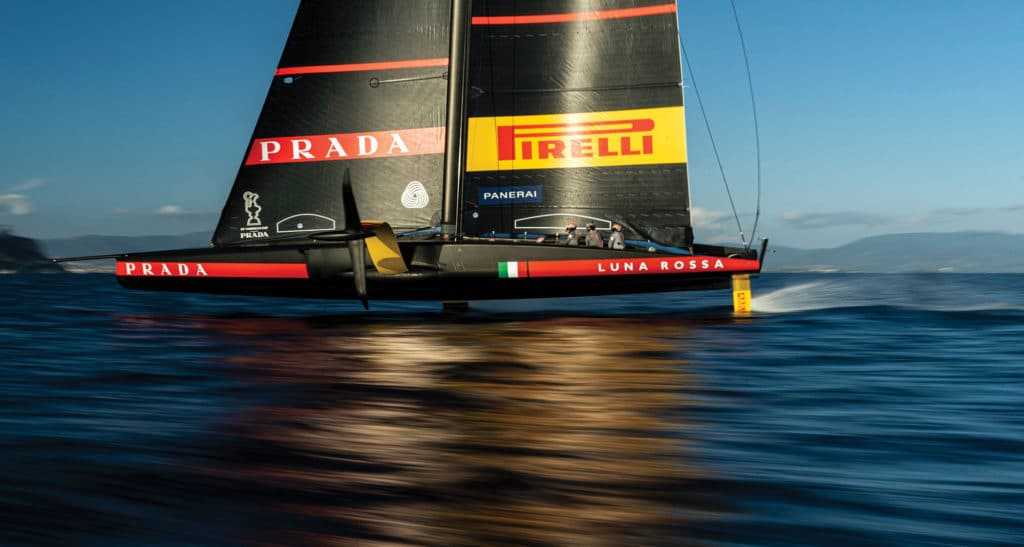
Below the perimeter line, differences between the boats are significant as well. Britannia has the fullest shape with the maximum beam extending right down to the waterline and carrying a U-shape aft to the transom. It’s also wider than the minimum 13-foot beam at the transom. It appears the boat might be close to the forward-beam maximum limits too. Britannia’s underbody is fair and smooth, with minimal rocker, which produces a shallow dish-like shape. It is by far the most stable hull, which should allow the sails to power up quicker and accelerate for takeoff, but the extra surface area might make it a bit sticky. This transition zone may become a critical area for all the teams.
American Magic’s Defiant has similar full‑hull sections and looks to be close to the maximum forward-beam limits, but with a narrower waterline than Britannia. It also has much softer sections and a strikingly different bulbous bow, which is likely aero-friendly. The transom section looks as if it’s close to the minimum beam limit and has a fairly low aft sheer line.
Prada Luna Rossa and Team New Zealand’s Te Aihe are the most similar with pronounced V-shaped sections blending into a rounded keelson, then blending forward and aft into the hull profile from stem to transom, deepest in the middle—with Prada Luna Rossa looking to be the deepest and sharpest of the two. One thought about the reasoning behind this is that distributing the required volume toward the centerline could allow for more windward heel before the hull edge touches the water. Certainly all hull touchdowns while foiling will be costly regardless of hull shape, but these shapes might reduce the effects of the touchdowns.
I suspect all of these hull and deck shapes are derived primarily based on computational fluid dynamics upwind-foiling velocity predictions. With some baseline sail shapes fixed, each team would have run through a matrix of different hull/deck shapes and crew positions that satisfied the rule limits and refined these shapes and crew arrangements to maximize overall straight-line performance. There are plenty of options here that give similar results. The full-foiling, dynamic simulations are complicated, but it is possible to include tacking and jibing with many assumptions and bottom-end limits.
Plenty of other work is being done on displacement sailing and transitions from partial-displacement sailing to foiling takeoff. Displacement foiling transitions require an extensive database to properly support the simulator’s velocity prediction and give useful results without too many assumptions. There is still a lot to learn from sailing these boats at full scale, especially in lower windspeeds. Compared to the AC50 and the AC72, the AC75 is a comparatively heavy boat with a short mast and no wing.
I’m curious to see how each package performs in 8 knots of wind—even 10 knots of windspeed—and how much the hull shapes contribute to performance in these marginal conditions. It all begs the question: What is the windspeed required to fly an AC75 around the entire racecourse?
The Foil Packages
From the early launches we’ve seen many different shapes emerge: straight wings, anhedral wings, fences, bulbs, no bulbs and winglets. Hardly surprising. Again, let’s first review the sandbox in which the teams are allowed to play. The trapezoidal area in the illustration below is the only zone in which teams can attach their wings and wing-control systems. Variations seen from each of the teams already are indicative of the many options available.
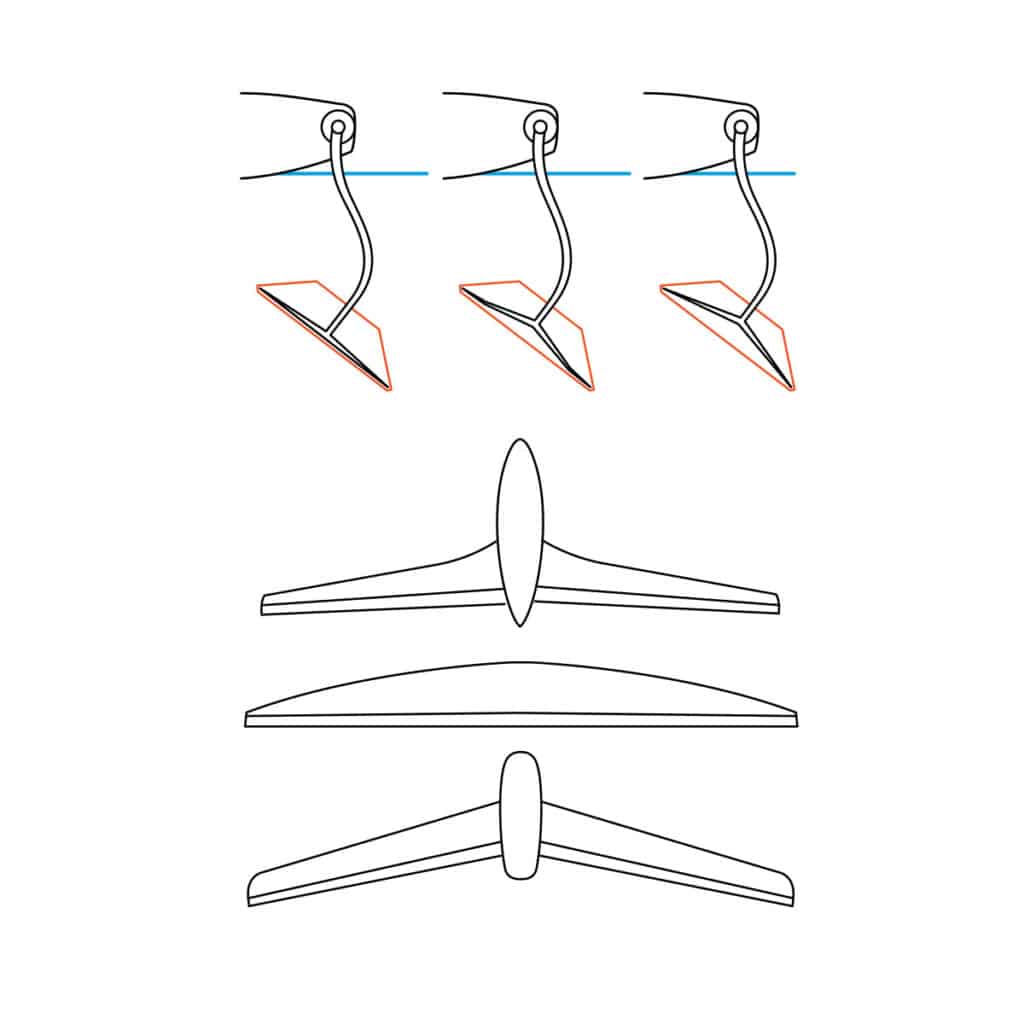
An additional requirement is ballasting in the wings. The rules mandate a certain level of stability, so the total weight of these wings must be at least 2,000 pounds.
Consequently, the boat’s overall center of gravity is low for low-speed handling. Teams are only allowed to build six wings, but are allowed to change up to 20 percent of the wing weight. Three of the four teams have elected to integrate bulbs into their wing designs. It’s conceivable that 80 percent of the wing weight is in these bulbs, which would allow the three teams to plug multiple wing designs into these same bulbs without them counting toward the six-wing limit.
Emirates Team New Zealand did not go in this direction, which means it could be more confident that it has enough options available and wants to develop shapes without bulbs to distribute the required volume into the foils. Steel has about 70 percent of the density of lead. The bulbs are likely to include lead, and Te Aihe’s foils are most likely all steel.
The flaps on these foils, like those on an airplane, control fly height, but it’s hard to glean much from the photos released to date. There are, however, flaps like those on Britannia that show a distinct line separating the main foil from the flap at around the last 30 percent of the main foil. Morphing foils have been around for some time; the rule requires a distinct axis of rotation for the flap, but allows for flexible material to act as the hinge. Some of the foil-flap intersections are indiscernible from the available images, so it is hard to tell exactly what Emirates Team New Zealand is doing here.
The one-design foil arms look pretty chunky, but have been structurally vetted through full-scale testing, which delayed the launches of these AC75s by about six months. The 2 to 4 feet of the foil arm are available for variation. Most teams have pushed to reduce the surface areas and thicknesses here, leading to steps or sharp reductions in the bottom of the foil arm, which will be in the water most of the time.
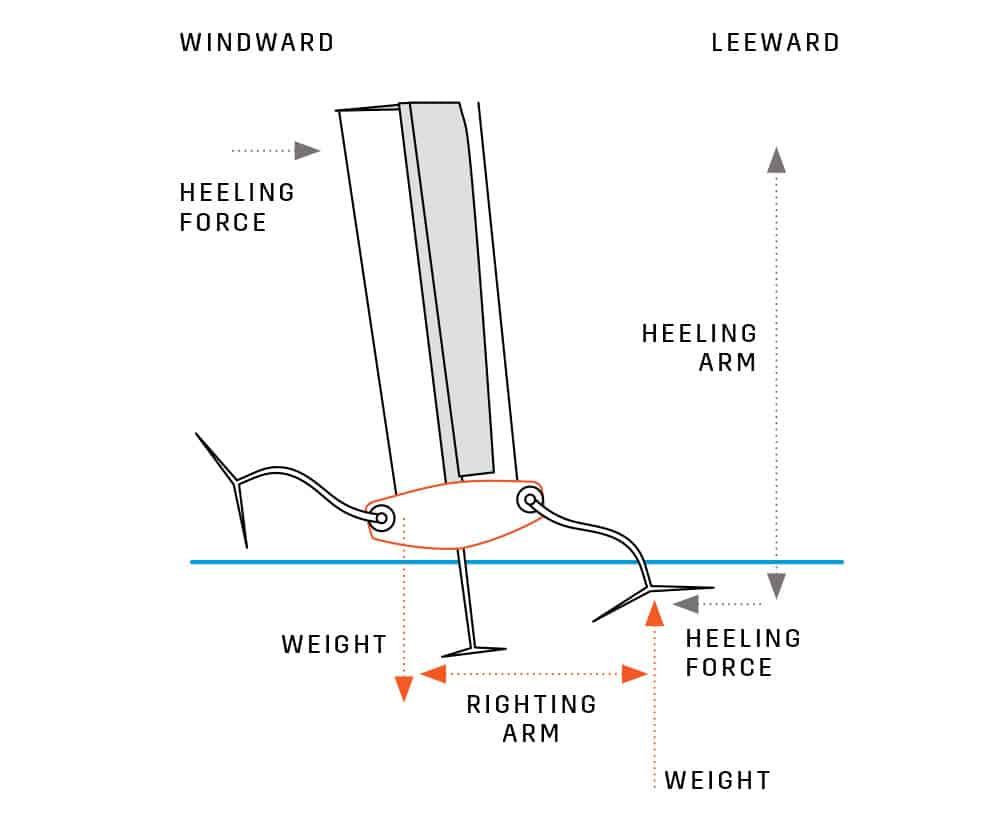
The above illustration shows the basic-force diagram of an AC75, looking from behind, in the foiling condition. Essentially, the boat’s weight working against the lifting foil provides an available righting moment against which the sails can push with heeling force.
A small portion of this heeling force is actually thrust forward, which is equal to the hydrodynamic drag of the foils in the water and the aero-drag of the boat in the airstream. The game is both maximizing thrust and minimizing drag.
These boats are interesting in that the foil arm can be rotated (or canted) to almost any angle. The farther outboard the foil arm is canted, the more righting moment the boat can develop, which can mean more speed. Many combinations of foil cant, boat-heel angle and fly height need to be quantified. Some early videos of Defiant and Te Aihe show the boats foiling with the hulls quite close to the water.
A boat’s distance to the water needs to be minimized both to increase the righting moment and to seal the lift from the sail plan against the water to reduce the vortices traveling around the hull. The foils need to be as close to the water surface as possible without ventilating.
What is under the hood—in other words, the parts we don’t see—might in fact be the most important aspect of the AC75. In the 12-Metre days of the Cup, some of the old guys used to say you could tell who was winning the race by the boat that was more heeled over.
With the AC75, it will likely be the boat with the smoothest flight and the ability to get settled quickly after maneuvers that will win in 2021. That said, all the internal systems controlling the foils and the sails are key elements to stable flight. All four teams promptly launched, sailed and foiled; however it appears that Team New Zealand and perhaps American Magic actually have significant air time.
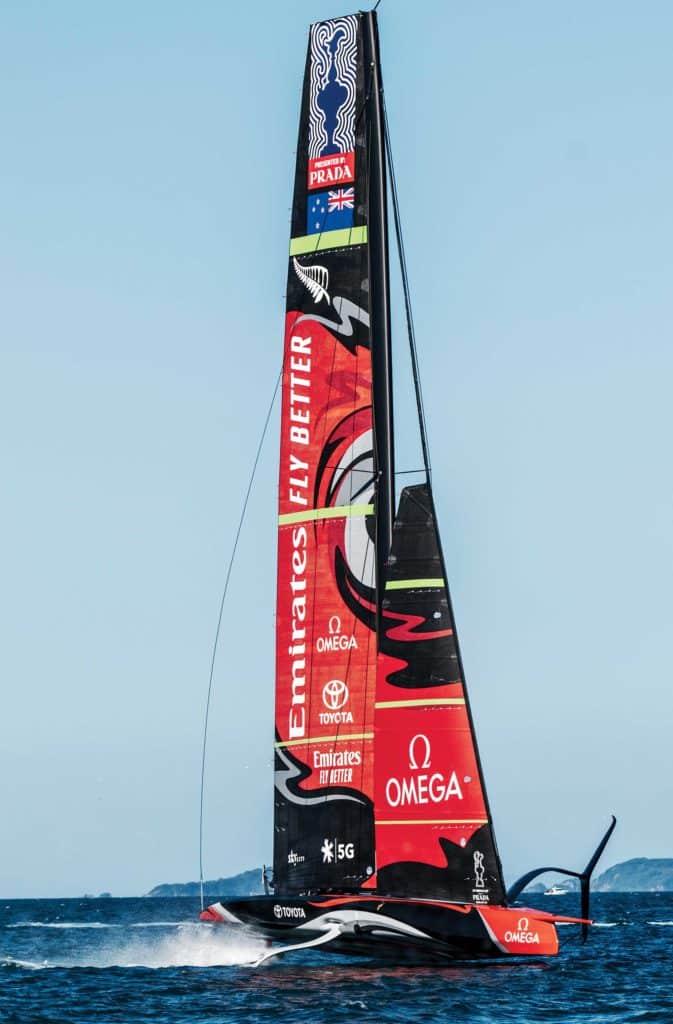
Team New Zealand appears pretty stable, much like it was in the 2017 Cup with the AC50; no doubt elements from that system have been incorporated into its AC75.
While internal controls are unseen, some portions of the external sail systems show obvious differences. Defiant, for example, sports a conventional boom, as does Te Aihe. However, Te Aihe’s sails extend all the way down to the deck. Britannia and Prada Luna Rossa appear to be boomless, with something closer to battens controlling the lower sail shape. The twin-skin mainsails are on all of the boats as dictated by the rule, along with the one-design mast and rigging.
It also appears that all teams are experiencing some downtime as they debug their new boats. These are complicated machines, so technical difficulties are to be expected. Sailing time, however, is precious for continued system development; so the teams must balance reliability versus potential gains because some of these time losses can cascade into larger problems.
While simulators are great training tools, there is no substitute for time on the water, which can lead to further overall development. Deadlines for each team’s second and final packages are fast approaching, and the sailors are eager to be on the water sailing, testing the designs and developing the skills required to sail these boats to their full potential. The first Prada Cup in April will certainly be the first true reckoning of concept, reliability and performance.


